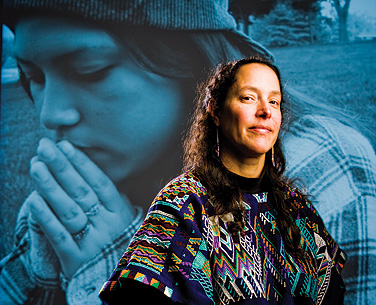Close Up
Native outreach comes from within

Contrary to her initial perception, Hilary Weaver found there is an active Native-American community in Buffalo. Photo: DOUGLAS LEVERE
-
 Print
Print -
 Comments
Comments
-
“Since I have the ability to conduct research, that’s a golden opportunity to really bridge the university and the community, to use my skills to the benefit of my community and help make things better for Native people here in Western New York.”
Hilary Weaver, a professor in the School of Social Work, always had a passion for her calling, but was searching for her niche as a student. While working toward her master’s degree and doctorate at Columbia University in the 1980s, she found her focus in cross-cultural studies as she began to work with the many refugee populations who came to New York City from places like Cuba and pre-Solidarity Poland. Weaver also became involved with indigenous populations—namely, Native Americans—a natural inclination for her as a member of the Lakota tribe.
While serving on a commission with the Council on Social Work Education, a national accrediting organization, she got to know Fred Seidl, dean of the UB School of Social Work at the time and also a member of the commission. He told her of a job opportunity at UB in 1993.
“After living in New York City, I didn’t want to be in the East,” recalled Weaver, who was raised in a small town in eastern Washington. “I agreed to what I thought would be a courtesy interview. I thought it would be good practice for when I interviewed at some place that I really wanted to be. I came out here thinking Buffalo would be similar to New York City—concrete canyons and that sort of thing. It didn’t look like that at all. Buffalo had these beautiful Victorian houses. It was a livable city, a community. I was very impressed by the different ethnic communities in Buffalo, the vibrant Native community, the refugees coming through here, the strong Puerto Rican community, the strong African-American community with its great historical legacy. Once I saw Buffalo, I thought maybe I could build a career here and make community connections.”
Weaver fulfilled that objective immediately, finding that there was a very active Native community here, contrary to her original perception. “I was impressed by the very strong cultural foundations,” she says. “I came from the West, so I had many of the same stereotypes that other people do—that there aren’t very many Native cultures that are still thriving in the East. We think of that as more of a western phenomenon, but that is not the case. There is a strong Native community here. It was quite impressive to see how culturally grounded many of the people are out here.”
As a member of the Native-American community, she feels it’s important to give back. “Since I have the ability to conduct research, that’s a golden opportunity to really bridge the university and the community, to use my skills to the benefit of my community and help make things better for Native people here in Western New York.”
Serving as a board member for Native American Community Services of Erie and Niagara County since 1994, she was approached for help in soliciting research funding when a request for proposals was sent to the agency by the National Cancer Institute. In 2006, with collaboration from the community, the Healthy Living in Two Worlds project was launched.
The project focused on the poor diet, early smoking habit and sedentary lifestyle that was characteristic of Native Americans, among the most obese populations in the country. The health risks were stacked against its urban youth, not the least of which is an often-unstructured home life that exacerbates those risks.
The project involved interventions in the form of a summer camp with urban Native youth from Buffalo ages 9 through 13. The five-week session encouraged healthy activity and balanced meals, while teaching the risks of smoking. The wellness curriculum reinforced the idea that being physically active is positive on so many different levels. For example, smoke dancing—a high-energy, traditional dance—was taught to the youngsters as a form of exercise, as well as a skill.
Weaver has a more comprehensive plan currently under consideration that expands the curriculum with an eye toward more effectively reaching the particularly troubled youth. The plan would also reach out to more youth in sites beyond Buffalo, including Niagara Falls and Rochester.
Meanwhile, Weaver is involved in various other projects and organizations with Native communities. She has served as president of the American Indian Alaska Native Social Work Educators’ Association for a number of years. While on sabbatical last fall, she took the opportunity to co-teach a course for Native people on interpersonal violence in Bethel, Alaska.
At UB, she is elated with the growth of the school and the grant support infrastructure that is now in place. “It’s very much a team approach,” she relates. “There is assistance with statistical or methodological data and a research center that I strategize with.”
Weaver lives on Buffalo’s West Side with her children: daughter Iris, born on the first day of the new millennium, and son Wanblee (the Lakota name for eagle), born the following year. Both are being raised as members of the urban Native community. The family has performed traditional dances together at powwows throughout the region, from Cattaraugus County to Fort Erie.
“I’ve run into so many people in Buffalo who don’t even know we have a strong Native community. We have had some of the best scholars on Native American issues here at UB, but we don’t even know what we have in our own backyard,” observes Weaver, who continues to use her Native influence toward rectifying that disconnect.

Reader Comments